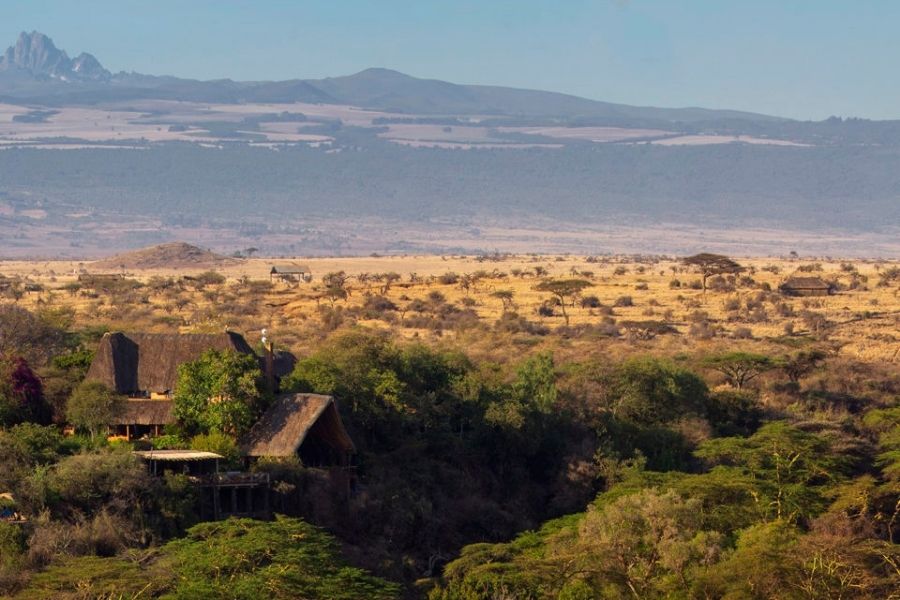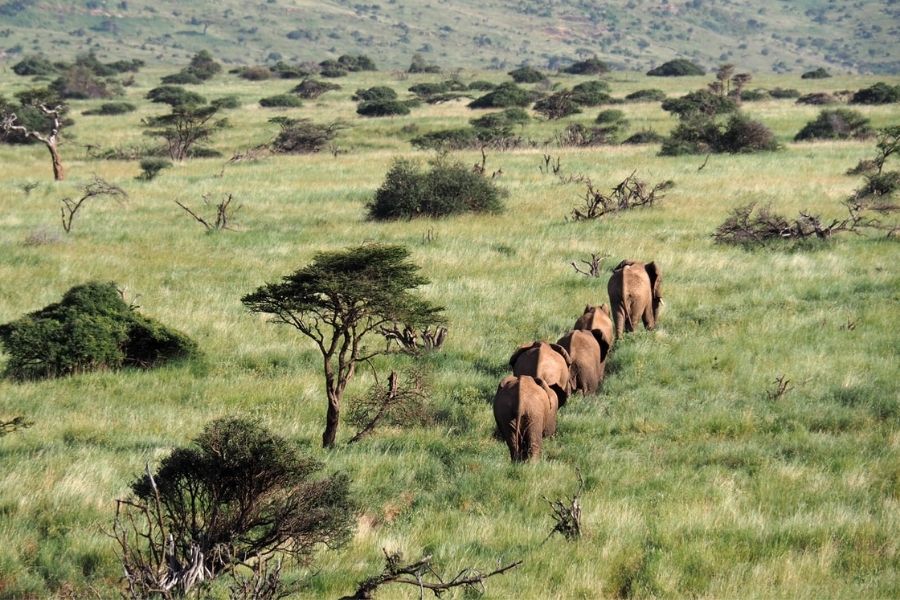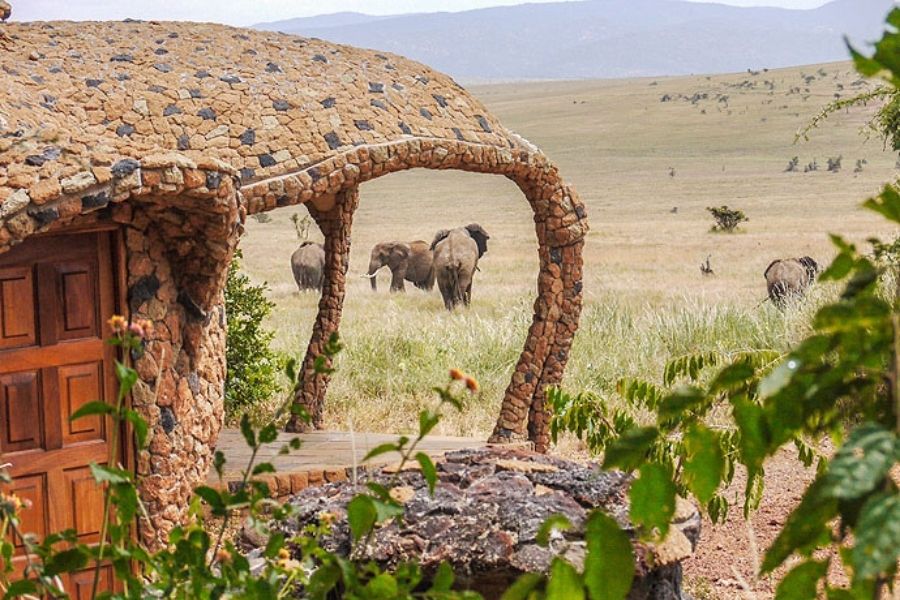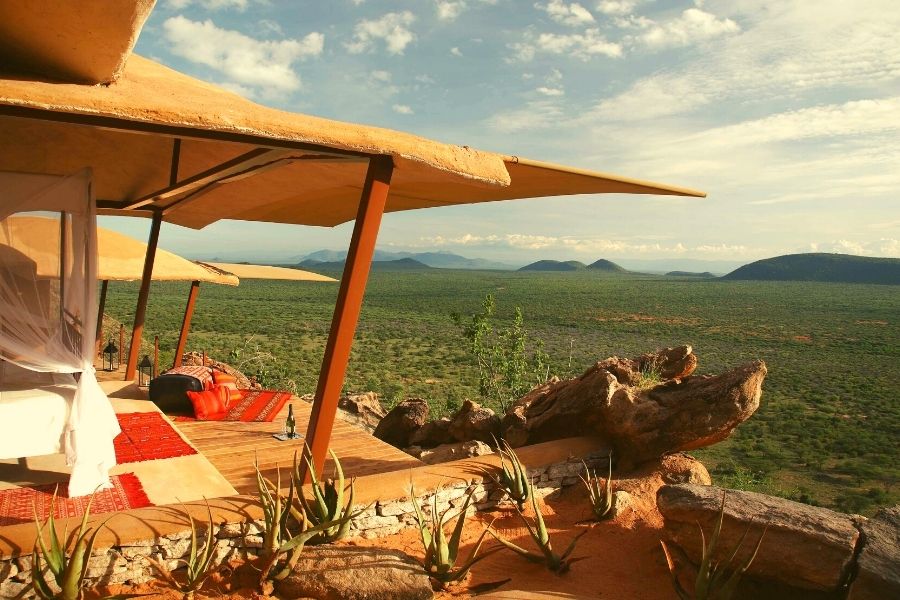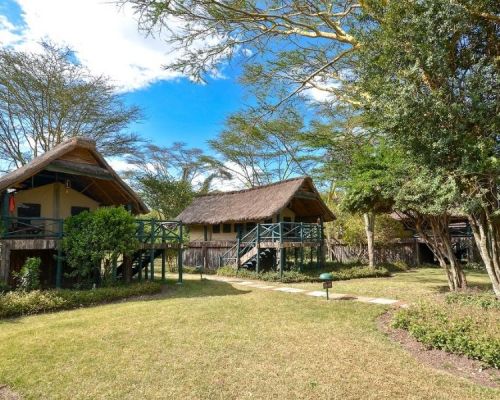OVERVIEW
Ol Pejeta Conservancy is a 90,000-acre wildlife conservancy located in Central Kenya. It is home to various wildlife, including black rhinos, elephants, lions, leopards, cheetahs, zebras, giraffes, and many more.
The Conservancy is also home to the world's last two northern white rhinos. The northern white rhino is critically endangered, and Ol Pejeta Conservancy is leading in its conservation.
Ol Pejeta Conservancy is a popular tourist destination, and visitors can enjoy various activities, including game drives, bush walks, and hot air balloon safaris. The Conservancy also offers a variety of educational programs and research opportunities.
Here are some of the things that make Ol Pejeta Conservancy unique:
- It is home to the last two northern white rhinos in the world.
- It is a leading center for rhino conservation research.
- It offers a variety of educational programs and research opportunities.
- It is a beautiful and biodiverse landscape.
Ol Pejeta Conservancy is a valuable asset to Kenya and to the world. It is a place where people can learn about and appreciate wildlife and support conservation efforts.
RHINO PROJECT
The Ol Pejeta Rhino Project is a conservation project dedicated to protecting rhinos, particularly the critically endangered northern white rhino. The project is located in Ol Pejeta Conservancy in Kenya, home to the last two northern white rhinos in the world.
The project works to protect rhinos from poaching and habitat loss. It also researches rhino biology and behavior and educates the public about rhino conservation.
The Ol Pejeta Rhino Project is a collaborative effort between the Kenya Wildlife Service, the African Parks Network, and Save the Rhino International. Various donors fund the project, including governments, foundations, and individuals.
The project has made significant progress in protecting rhinos. Recently, the number of rhinos poached in Kenya has declined significantly. The project has also successfully relocated rhinos to other safe areas in Africa.
The Ol Pejeta Rhino Project is a vital lifeline for the northern white rhino. The project is working to ensure that these magnificent animals survive and thrive.
Here are some of the specific activities that the Ol Pejeta Rhino Project undertakes:
- Anti-poaching: The project works to deter and prevent poaching of rhinos. This includes patrolling the Conservancy, using anti-poaching technology, and working with local communities to raise awareness about the dangers of poaching.
- Habitat protection: The project works to protect rhino habitat from degradation and loss. This includes planting trees, restoring degraded areas, and managing grazing.
- Research: The project researches rhino biology and behavior. This research helps the project understand rhinos better and develop more effective conservation strategies.
- Education: The project educates the public about rhino conservation. This includes school programs, outreach events, and social media campaigns.
The Ol Pejeta Rhino Project is valuable to Kenya and the world. It is working to save the northern white rhino from extinction, providing an important example of how to conserve rhinos and other wildlife.
SWEETWATERS CHIMPS SANCTUARY
Sweetwaters Chimpanzees Sanctuary is a wildlife sanctuary in Ol Pejeta Conservancy in Kenya. It is home to over 100 chimpanzees, many of whom have been rescued from the illegal pet trade or situations of abuse.
The sanctuary provides a safe and loving home for these chimpanzees, and it works to rehabilitate them so that they can be returned to the wild if possible. The sanctuary also conducts essential research on chimpanzee behavior and conservation.
The sanctuary is open to visitors, and they can learn about the chimpanzees and their conservation through educational programs and tours. Visitors can also see the chimpanzees up close during feeding and enrichment activities.
The Sweetwaters Chimpanzees Sanctuary is a vital lifeline for these endangered animals. It is working to protect them from harm and ensure they have a future in the wild.
Here are some of the things that make Sweetwaters Chimpanzees Sanctuary unique:
- It is one of the few sanctuaries dedicated to rehabilitating and conserving chimpanzees.
- It has a high success rate in returning chimpanzees to the wild.
- It conducts essential research on chimpanzee behavior and conservation.
- It is open to visitors, who can learn about the chimpanzees and their conservation through educational programs and tours.
Sweetwaters Chimpanzees Sanctuary is a valuable asset to Kenya and to the world. It is working to save chimpanzees from extinction, providing an important example of how to conserve endangered wildlife.
Game Drives
A game drive in Ol Pejeta Conservancy is a unique and unforgettable experience. The Conservancy is home to various wildlife, including the last two northern white rhinos worldwide. Visitors can also see black rhinos, elephants, lions, leopards, cheetahs, zebras, giraffes, and many more animals.
Game drives in Ol Pejeta Conservancy are typically conducted in open-top safari vehicles. This allows visitors to have a close-up view of the animals and experience the African bush's beauty.
The best time for a game drive in Ol Pejeta Conservancy is morning or evening. This is when the animals are most active and when they are more likely to be seen.
Here are some of the things that you can see on a game drive in Ol Pejeta Conservancy:
- Northern white rhinos: Ol Pejeta Conservancy is home to the world's last two northern white rhinos. These magnificent animals are critically endangered and are a highlight of any game drive in the Conservancy.
- Black rhinos: Black rhinos are another endangered species, and they are also found in Ol Pejeta Conservancy. Black rhinos are smaller than white rhinos but still awe-inspiring animals.
- Elephants: Elephants are one of Africa's most iconic animals and are also found in the Ol Pejeta Conservancy. Elephants are social animals, and they often travel in herds.
- Lions: Lions are Africa's apex predators and are also found in the Ol Pejeta Conservancy. Lions are often seen resting in the shade during the day, but they can also be seen hunting at night.
- Leopards: Leopards are solitary animals that are often difficult to see. However, they can be found in Ol Pejeta Conservancy, and visitors may be lucky enough to spot one of these elusive cats.
- Cheetahs: Cheetahs are the fastest land animals on Earth and are also found in the Ol Pejeta Conservancy. Cheetahs are often seen hunting gazelles and other antelopes.
- Zebras: Zebras are among the most common animals in the Ol Pejeta Conservancy. They are social animals, and they often travel in herds.
- Giraffes: Giraffes are another iconic African animal, and they are also found in Ol Pejeta Conservancy. Giraffes are the tallest land animals on Earth, often seen grazing on trees.
In addition to the animals listed above, visitors to Ol Pejeta Conservancy may also see a variety of other animals, such as buffalo, hyenas, jackals, and warthogs.
A game drive in Ol Pejeta Conservancy is a truly unforgettable experience. Visitors can see a variety of wildlife in their natural habitat. It is a great way to learn about African wildlife and appreciate the beauty of the African bush.
Horse Riding
Horse riding is a popular activity at Ol Pejeta Conservancy. There are a variety of horse riding trails available, ranging from beginner to experienced riders. Riders can enjoy stunning views of the Conservancy's wildlife and landscapes.
One of the most famous horse riding trails at Ol Pejeta Conservancy is the Rhino Trail. This trail takes riders through the Conservancy's rhino sanctuary, where they can see the world's last two northern white rhinos.
Another famous horse-riding trail is the Buffalo Trail. This trail takes riders through the Conservancy's buffalo population, where they can get close to these majestic animals.
Horse riding is a great way to experience the beauty and wildlife of Ol Pejeta Conservancy. It is also a great way to get some exercise and fresh air.
Here are some of the benefits of horse riding at Ol Pejeta Conservancy:
- It is a great way to see the Conservancy's wildlife and landscapes.
- It is a fun and challenging activity for riders of all levels.
- It is a great way to get some exercise and fresh air.
- It is a unique and memorable experience.
If you are interested in horse riding at Ol Pejeta Conservancy, there are a few things you should keep in mind:
- Book your horse ride in advance, especially if you are visiting during peak season.
- Wear comfortable clothing and shoes that you can move around in quickly.
- Bring sunscreen, insect repellent, and a hat.
- Be aware of your surroundings and be respectful of the wildlife.
- Follow the instructions of the guide and rangers.
Horse riding at Ol Pejeta Conservancy is a great way to experience the beauty and wildlife of Kenya. It is also a great way to exercise and is amazingly refreshing.
IT IS THE BEST TIME TO VISIT LAIKIPIA FOR A NORTHERN KENYA SAFARI.
The best time for wildlife viewing is from July to September and January to March. The soil in the region is primarily black cotton soil, which becomes very difficult to navigate after heavy rain. Wildlife viewing can become problematic in April and November – the wettest months. 4x4 vehicles are a must during the rainy season.
Although Laikipia is an excellent Kenyan safari destination throughout the year, the following information will help you decide what time of year may suit your desires for your wilderness travel with AfricanMecca. You should note that, like other locations in Kenya, Laikipia experiences two dry seasons and two rainy seasons that significantly affect the ease with which you may view wildlife.
The long, cool-dry season occurs from July to October, and the short, hot-dry season occurs in January and February. During these times, water sources are limited, so wildlife is easily gathered near or around the last remaining water sources. The conservancies in Laikipia have many wetlands that attract yet disperse an abundance of animals during the short rains in November and December and the long rains from April to June.
The long, cool-dry season occurs from July to October, and the short, hot-dry season occurs in January and February. During these times, water sources are limited, so wildlife is easily gathered near or around the last remaining water sources. The conservancies in Laikipia have many wetlands that attract yet disperse an abundance of animals during the short rains in November and December and the long rains from April to June.
The individual conservancies within the parent Laikipia ecology are exclusive, so you will most certainly interact with fewer guests than in other destinations in Kenya. Still, there are times when guest levels are higher. The limited accommodations may also be fully booked as a result. The long dry season is the best time to visit Laikipia and other game-viewing destinations in Kenya.
The reason for this is not only the ease and accessibility of wildlife viewing or due to wildebeest migration in Masai Mara from August to October, but this time of year also coincides with summer vacations to East Africa for European and American families. Festive holidays, including Christmas, New Year's, and Easter, are also popular times when Laikipia has increased the number of family visitors on a bonding retreat in Kenya.
The long rainy season has fewer guests and increases the moisture, which transforms the landscape. Lush grasslands and the arrival of newborn animals, especially antelopes, make this time of year perfect for an intimate and riveting bush holiday at Laikipia. Because this is considered the low or green tourist season, room rates are lower, although other costs do not change throughout the year, such as guided activities, park fees, and logistics (read more on where to stay in Laikipia).
The reason for this is not only the ease and accessibility of wildlife viewing or due to wildebeest migration in Masai Mara from August to October, but this time of year also coincides with summer vacations to East Africa for European and American families. Festive holidays, including Christmas, New Year's, and Easter, are also popular times when Laikipia has increased the number of family visitors on a bonding retreat in Kenya.
The long rainy season has fewer guests and increases the moisture, which transforms the landscape. Lush grasslands and the arrival of newborn animals, especially antelopes, make this time of year perfect for an intimate and riveting bush holiday at Laikipia. Because this is considered the low or green tourist season, room rates are lower, although other costs do not change throughout the year, such as guided activities, park fees, and logistics (read more on where to stay in Laikipia).
Bird lovers may prefer to plan their travel from October to April when migratory species arrive at Laikipia from as far as Europe and Russia. Weather patterns also affect the logistics of your wildlife viewing. When there is little rainfall, the moisture evaporates quickly because Laikipia is located near the equator, where it usually is warmer. More significant rain makes the roads muddy and somewhat tricky to navigate. Additionally, the trails used for walking safaris may be slippery.
Activities like helicopter safaris, camel rides, and horseback safaris may only be offered when the weather cooperates with such outdoor excursions. Temperatures vary during the year from the daytime highs of 71 F (22 C) in the cooler months to 90 (32 C) in the hotter humid months to nighttime lows of 50 F (10 C) to 57 (14 C) degrees with variability depending on the season of visit. Where you are staying in Laikipia, but temperatures tend to be more relaxed in the highlands, especially in the evenings through early mornings.
Southern Laikipia is much more relaxed, being closer to Nanyuki, compared to Northern Laikipia, where you are bordering the Northern Frontier District. AfricanMecca recommends bringing a warm fleece or sweater for your comfort as you will need it, especially during early morning and evening game drives.
Activities like helicopter safaris, camel rides, and horseback safaris may only be offered when the weather cooperates with such outdoor excursions. Temperatures vary during the year from the daytime highs of 71 F (22 C) in the cooler months to 90 (32 C) in the hotter humid months to nighttime lows of 50 F (10 C) to 57 (14 C) degrees with variability depending on the season of visit. Where you are staying in Laikipia, but temperatures tend to be more relaxed in the highlands, especially in the evenings through early mornings.
Southern Laikipia is much more relaxed, being closer to Nanyuki, compared to Northern Laikipia, where you are bordering the Northern Frontier District. AfricanMecca recommends bringing a warm fleece or sweater for your comfort as you will need it, especially during early morning and evening game drives.
WHERE TO STAY IN LAIKIPIA CONSERVANCIES.
Our classification systems give you the accurate insight you need to have an unforgettable safari to Kenyaby use of three categories – Premier luxury, Mid-range deluxe, and Budget value, which will ultimately help you find the accommodation combined with safari experiences that perfectly suit your individual travel preference and budgetary needs.
Most accommodations at Laikipia are deluxe to exclusive, so the ratings reflect the location based on maximal wildlife viewing, quality of services, guest rooms, amenities, cuisine, facilities, guides, and inclusion of varied activities.
We recommend Premier luxury accommodations such as Lewa Wilderness and Elewana Loisaba Tented Camp in Laikipia. With its nine rooms, Lewa Wilderness offers premium accommodation in the Eastern Marania Valley. You spend your days and nights amidst a beautiful 62,000-acre privately-owned conservancy – Lewa Conservancy, one of the top-known conservancies in Laikipia, Kenya, and Africa. Lewa is best known for the neoteric "elephant corridor" constructed to allow migratory wildlife to be moved.
The second Premier luxury accommodation we recommend is Elewana Loisaba Tented Camp, within a community-owned 61,000-acre conservancy. Members of the Maasai and Samburu peoples are your hosts, and you enjoy the utmost service while staying in one of the eleven guest tents at Loisaba Bush Camp, six stars at two separate sites (Kiboko and Koija) and the family-suitable Loisaba Cottage with four rooms.
The second Premier luxury accommodation we recommend is Elewana Loisaba Tented Camp, within a community-owned 61,000-acre conservancy. Members of the Maasai and Samburu peoples are your hosts, and you enjoy the utmost service while staying in one of the eleven guest tents at Loisaba Bush Camp, six stars at two separate sites (Kiboko and Koija) and the family-suitable Loisaba Cottage with four rooms.
Mid-range deluxe recommendations include Lewa Safari Camp in Lewa Conservancy and IL N'gwesi for visitors who desire a balance between quality and price. Lewa Safari Camp offers 12 guest tents with ensuite bathrooms and private verandahs for breathtaking views of the conservancies. IL N'gwesi is a community-owned and operated conservancy where you are treated to your private eco-banda.
All six bands on the property are built from local materials, with stunning views. The ensuite bathroom with outdoor shower and private verandah makes you feel nestled within your intimate space of the East African bush.
All six bands on the property are built from local materials, with stunning views. The ensuite bathroom with outdoor shower and private verandah makes you feel nestled within your intimate space of the East African bush.
We recommend the economical Budget value accommodations of Laikipia Wilderness Camp and El Karama Eco Lodge for a budget-friendly trip to Laikipia. Laikipia Wilderness Camp is near the Ewaso Narok River, with spectacular views of Mount Kenya. The five-tent camp takes great pride in minimizing the impact on the environment.
As such, solar-generated electricity and guest accommodations are modest yet comfortable and very personable. Surrounded by 14,000 acres in central Laikipia wilderness, El Karama Eco Lodge features six guest rooms and accommodates a maximum of eighteen guests. Solar electricity is used for hot water, lighting, and power, and the property is also lit with traditional lanterns. Rainwater is collected and filtered for drinking.
As such, solar-generated electricity and guest accommodations are modest yet comfortable and very personable. Surrounded by 14,000 acres in central Laikipia wilderness, El Karama Eco Lodge features six guest rooms and accommodates a maximum of eighteen guests. Solar electricity is used for hot water, lighting, and power, and the property is also lit with traditional lanterns. Rainwater is collected and filtered for drinking.
When visiting a conservancy in Laikipia, we recommend combining your safari to Masai Mara for the wildebeest migration, Amboseli, Nakuru, Elementaita, and Naivasha - Great Rift Valley Lakes. You can also climb the 2nd highest mountain in Africa: Mount Kenya.
You can end your vacation on the Indian Ocean with a beach vacation and Swahili cultural tour in the exotic spice island of Zanzibar Lamu or even Mombasa.

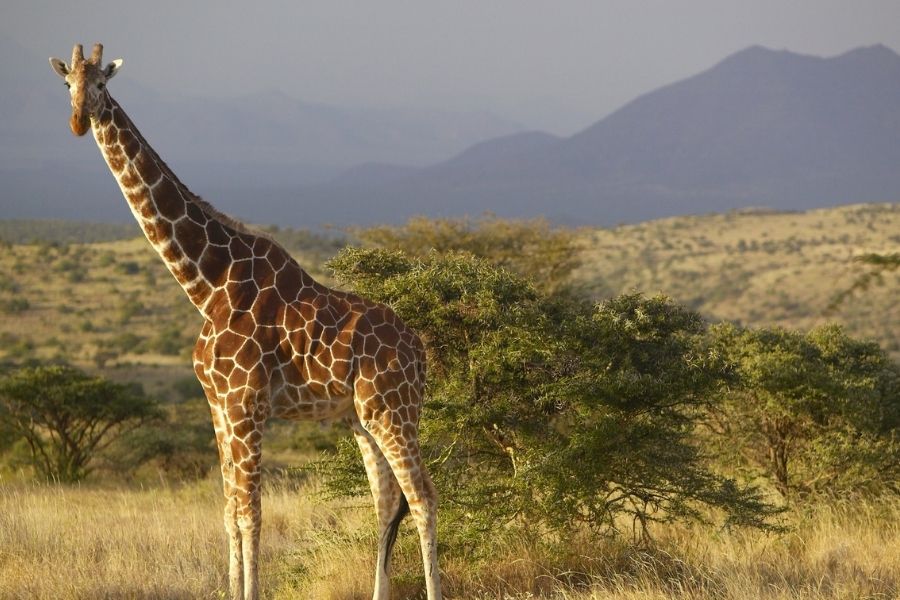
.jpg)
